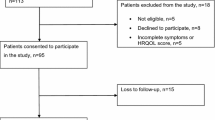Abstract
Introduction and hypothesis
The objective was to determine the effect of uterine fibroid embolization (UFE) on lower urinary tract symptoms (LUTS) and quality of life (QoL).
Methods
This prospective study included women with symptomatic fibroids and LUTS who underwent UFE between March 2008 and May 2010. Subjects underwent pre-procedural pelvic magnetic resonance imaging (MRI) and completed the Urogenital Distress Inventory (UDI-6), Incontinence Impact Questionnaire (IIQ-7), Prolapse and Incontinence Sexual Questionnaire (PISQ-12), Uterine Fibroid Symptom Quality of Life questionnaire (UFS-QoL), and a standardized 48-h bladder diary at baseline and 3 months after the procedure. Patient Global Impression of Improvement (PGI-I) assessed post-procedural patient satisfaction. The primary outcome was subjective improvement in LUTS at 3 months, as measured by a decrease in UDI-6 score. Univariate analysis, paired t test and a stepwise regression analysis were appropriately conducted.
Results
Fifty-seven patients underwent UFE and completed bladder diaries and questionnaires. At 3 months after UFE, patients reported a significant decrease in UDI-6, IIQ-7, and UFS-QoL, indicating an improvement in urinary symptoms and QoL. Bladder diaries showed a significant reduction in daytime and night-time voids. No difference was found in incontinence episodes. Uterine volume, dominant fibroid size, fibroid location, and MRI-confirmed bladder compression did not affect the difference in UDI-6 scores. In a stepwise regression model, BMI had a significant impact on the change in UDI-6 score, with a decrease of 1.18 points for each 1 unit increase in BMI.
Conclusion
Uterine fibroid embolization significantly improves LUTS and urinary-related QoL. Obesity seems to attenuate this effect.
Similar content being viewed by others
References
Baird DD, Dunson DB, Hill MC, Cousins D, Schectman JM (2003) High cumulative incidence of uterine leiomyoma on black and white women: ultrasound evidence. Am J Obstet Gynecol 188:100–107
Wallach EE, Vlahos NF (2004) Uterine myomas: an overview of development, clinical features, and management. Obstet Gynecol 104:393–406
Flynn M, Jamison M, Datta S, Myers E (2006) Health care resource use for uterine fibroid tumors in the United States. Am J Obstet Gynecol 195:955–964
Pron G, Cohen M, Soucie J, Garvin G, Vanderburgh L, Bell S, Ontario Uterine Fibroid Embolization Collaboration Group (2003) The Ontario Uterine Fibroid Embolization Trial. I. Baseline patient characteristics, fibroid burden, and impact on life. Fertil Steril 79(1):112–119
Learman LA, Summitt RL Jr, Varner RE, McNeeley SG, Goodman-Gruen D, Richter HE, Lin F, Showstack J, Ireland CC, Vittinghoff E, Hulley SB, Washington AE, Total or Supracervical Hysterectomy (TOSH) Research Group (2003) A randomized comparison of total or supracervical hysterectomy: surgical complications and clinical outcomes. Obstet Gynecol 102(3):453–462
Pron G, Bennett J, Common A, Wall J, Asch M, Sniderman K, Ontario Uterine Fibroid Embolization Collaboration Group (2003) The Ontario Uterine Fibroid Embolization Trial. II. Uterine fibroid reduction and symptom relief after uterine artery embolization for fibroids. Fertil Steril 79(1):120–127
Spies JB, Cornell C, Wothington-Kirsch R, Lipman J, Benenati JF (2007) Long-term outcome from uterine fibroid embolization with tris-acryl gelatin microspheres: results of a multicenter study. J Vasc Interv Radiol 18:203–207
Bucek RA, Puchner S, Lammer J (2006) Mid- and long-term quality-of-life assessment in patients undergoing uterine fibroid embolization. AJR Am J Roentgenol 186(3):877–882
Spies JB, Cooper JM, Worthington-Kirsch R, Lipman J, Mills BB, Benenati JF (2004) Outcome of uterine embolization and hysterectomy for leiomyomas: results of a multicenter study. Am J Obstet Gynecol 191:22–31
Goodwin SC, Spies JB, Worthington-Kirsch R, Peterson E, Pron G, Li S et al (2008) Uterine artery embolization for treatment of leiomyomata long-term outcomes from the FIBROID Registry. Obstet Gynecol 111(1):22–33
Barber MD, Walters MD, Bump RC (2005) Short forms of two condition-specific quality-of-life questionnaires for women with pelvic floor disorders (PFDI-20 and PFIQ-7). Am J Obstet Gynecol 193:103–113
Rogers R, Kammerer-Doak D, Villarreal A, Coates K, Qualls C (2001) A new instrument to measure sexual function in women with urinary incontinence or pelvic organ prolapse. Am J Obstet Gynecol 184:552–558
Spies JB, Coyne K, Guaou Guaou N, Boyle D, Skyrnarz-Murphy K, Gonzalves SM (2002) The UFS-QOL, a new disease-specific symptom and health-related quality of life questionnaire for leiomyomata. Obstet Gynecol 99(2):290–300
Harding G, Coyne KS, Thompson CL, Spies JB (2008) The responsiveness of the uterine fibroid symptom and health-related quality of life questionnaire (UFS-QOL). Health Qual Life Outcomes 6:99
Barber MD, Spino C, Janz NK, Brubaker L, Nygaard I, Nager CW, Wheeler TL (2009) The minimum important differences for the urinary scales of the Pelvic Floor Distress Inventory and Pelvic Floor Impact Questionnaire. Am J Obstet Gynecol 200(5):580.e1–580.e7
Urwitz-Lane R, Ozel B (2006) Sexual function in women with urodynamic stress incontinence, detrusor overactivity, and mixed urinary incontinence. Am J Obstet Gynecol 195(6):1758–1761
Aschkenazi SO, Rogers RG, Beaumont J, Botros SM, Sand PK, Goldberg RP (2010) A valid form of the PISQ-12, the PISQ-9, for use in comparative studies of women with and without pelvic organ prolapse and/or urinary incontinence. Female Pelvic Med Reconstr Surg 16(4):218–223
Arleo EK, Tal MG (2008) Fibroid-induced acute urinary retention: treatment by uterine artery embolization. Int Urogynecol J Pelvic Floor Dysfunct 19(1):161–165
Acknowledgements
The authors would like to acknowledge Jaime Lee, CRNP, and Michelle M. Jones, CRNP, for their unique and critical contribution to this study. This study was supported by a grant from the MedStar Health Research Institute Graduate Medical Education.
Conflicts of interest
None.
Author information
Authors and Affiliations
Corresponding author
Rights and permissions
About this article
Cite this article
Shveiky, D., Iglesia, C.B., Antosh, D.D. et al. The effect of uterine fibroid embolization on lower urinary tract symptoms. Int Urogynecol J 24, 1341–1345 (2013). https://doi.org/10.1007/s00192-012-2013-7
Received:
Accepted:
Published:
Issue Date:
DOI: https://doi.org/10.1007/s00192-012-2013-7




